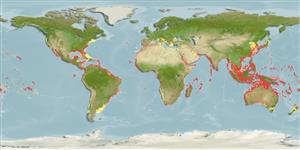Common names from other countries
>
Carangiformes (Jacks) >
Echeneidae (Remoras)
Etymology: Echeneis: Greek, echein = to hold + Greek, nays = ship; remora, suckling fish; 1774 (Ref. 45335).
More on author: Linnaeus.
Environment: milieu / climate zone / profondeur / distribution range
Écologie
marin; saumâtre récifal; profondeur 1 - 85 m (Ref. 86942). Subtropical; 45°N - 45°S, 180°W - 180°E
Circumtropical.
Taille / Poids / Âge
Maturité: Lm ? range ? - ? cm
Max length : 110 cm TL mâle / non sexé; (Ref. 9710); common length : 66.0 cm SL mâle / non sexé; (Ref. 10970); poids max. publié: 2.3 kg (Ref. 40637)
Épines dorsales (Total) : 0; Rayons mous dorsaux (Total) : 32 - 42; Épines anales: 0; Rayons mous anaux: 29 - 41.
Body shape (shape guide): elongated.
Most abundant remora in warm waters (Ref. 4389). Occurs near as well as far from the coast (Ref. 5217). Often found free-swimming in shallow inshore areas and around coral reefs (Ref. 26938). Attaches temporarily to a variety of hosts including sharks, rays, large bony fishes or sea turtles, whales, dolphins and also to ships. May follow divers (Ref. 9710); reported to attach itself to a diver's leg (Ref. 57809). Feeds on small fishes, bits of its host's prey and host's parasites (Ref. 26938). Juveniles occasionally act as reef station-based cleaners, where they service parrotfishes (Ref. 40095). Sometimes used by natives to aid in fishing; a line is tied to the caudal peduncle of the remora and then is released; upon attaching to another fish, the remora and its host are hauled in by the fisher (Ref. 9682).
Life cycle and mating behavior
Maturité | Reproduction | Frai | Œufs | Fécondité | Larves
Paxton, J.R., D.F. Hoese, G.R. Allen and J.E. Hanley, 1989. Pisces. Petromyzontidae to Carangidae. Zoological Catalogue of Australia, Vol. 7. Australian Government Publishing Service, Canberra, 665 p. (Ref. 7300)
Statut dans la liste rouge de l'IUCN (Ref. 130435: Version 2025-1)
Menace pour l'homme
Harmless
Utilisations par l'homme
Pêcheries: intérêt commercial mineur; pêche sportive: oui; Aquarium: Commercial
Outils
Articles particuliers
Télécharger en XML
Sources Internet
Estimates based on models
Preferred temperature (Réf.
123201): 18.3 - 28.6, mean 27.2 °C (based on 566 cells).
Phylogenetic diversity index (Réf.
82804): PD
50 = 0.7539 [Uniqueness, from 0.5 = low to 2.0 = high].
Bayesian length-weight: a=0.00257 (0.00110 - 0.00600), b=3.17 (2.96 - 3.38), in cm total length, based on LWR estimates for this (Sub)family-body shape (Ref.
93245).
Niveau trophique (Réf.
69278): 3.7 ±0.3 se; based on diet studies.
Résilience (Réf.
120179): Milieu, temps minimum de doublement de population : 1,4 à 4,4 années (Assuming Fec < 10,000).
Fishing Vulnerability (Ref.
59153): High to very high vulnerability (66 of 100).
🛈
Nutrients (Ref.
124155): Calcium = 22.5 [10.7, 37.1] mg/100g; Iron = 0.59 [0.32, 0.99] mg/100g; Protein = 19.8 [18.7, 20.8] %; Omega3 = 0.128 [0.068, 0.250] g/100g; Selenium = 28.3 [13.0, 54.4] μg/100g; VitaminA = 25.8 [8.3, 87.1] μg/100g; Zinc = 0.702 [0.456, 1.085] mg/100g (wet weight);
